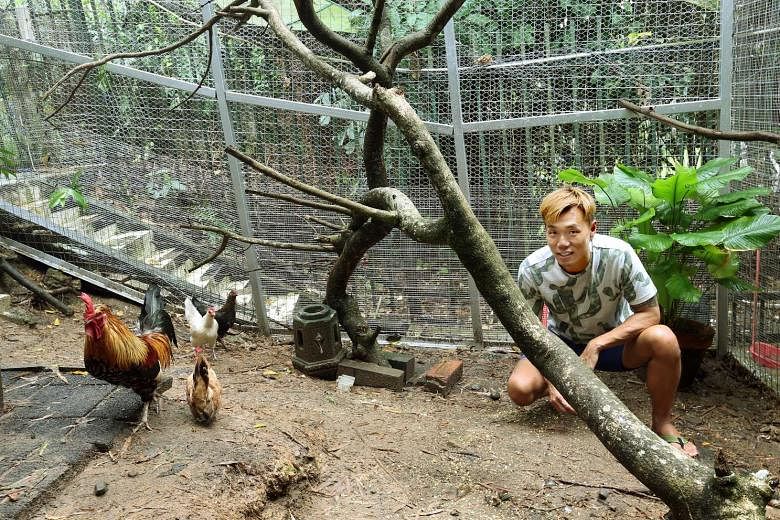SINGAPORE - For a while, their future looked bleak. But now, six of Sin Ming's remaining free-ranging chickens have a new chance at life.
The caveat: residents in the area will no longer be able to enjoy their antics.
Animal rescue volunteer Derrick Tan, who founded dog rescue group Voices for Animals (VFA), has rounded up six birds and placed them in an aviary in Bukit Timah's Turf City, where he runs Sunny Heights - a daycare centre for dogs.
"Many people were upset when the authorities killed the chickens, but no one was stepping forward to do anything about it. So my team and I decided that since we have space, we can rescue some of them," said Mr Tan.
His actions followed a public outcry over the Agri-Food and Veterinary Authority's (AVA) culling of 24 out of some 50 dozen free-ranging chickens in Sin Ming in January 2017, after it received 20 complaints about the fowls being noisy. The AVA had said that it took action to safeguard public health and mitigate nuisance issues.
But before Mr Tan could rescue the chickens, he had to build a place for the birds, as per regulations set by the AVA.
"The keeping of chickens by VFA is allowed as long as the chickens are kept according to AVA's guidelines," an AVA spokesman said, adding that the AVA allows a maximum of 10 chickens to be kept within bird-proof cages or enclosures.
"Breeding of the chickens is not allowed," the spokesman said.
Mr Tan has taken precautions to prevent breeding. He has created a "nest" out of an old basket covered with leaves where the hens can lay eggs. The nest is tilted at an angle, so laid eggs will roll to a separate "drain", where the eggs can be collected and consumed instead of hatching into chicks.
Mr Tan noted that enclosures could include a fine wire mesh netting, which prevents the kept birds from having any contact with any other bird or animal from outside the cage. The cage must also have a proper roof.
He got to work about two weeks ago, enlisting the help of a friend who used to work in construction to build the aviary, which measures about 4m by 5m. The aviary is also about 2m high, and is large enough for a person to walk about in it without crouching.
Mr Tan he said he spent about $2,500 on the structure, most of which he paid out of his own pocket. He also received about $500 in donations from friends.
The construction of the aviary was complete in about a week. The next step was to catch the birds, which Mr Tan did with the help of friends and advice from staff at a temple in Sin Ming.
"We first had to explain to the temple staff that we were not catching the birds to cull them, but to rescue them," said Mr Tan. "They gave us tips on where we could find the birds after that, and even lent us a ladder so we could reach them in the tree."
Mr Tan also got in touch with Dr Kenneth Tong, a veterinarian from the Animal and Avian Veterinary Clinic, for advice on diet, bird welfare and husbandry issues.
Mr Tan hopes some chickens would be adopted so more can be rescued if need be. "We built this coop as an example of how chickens can be kept on private property in a humane way, and not in tiny cages," he said.



